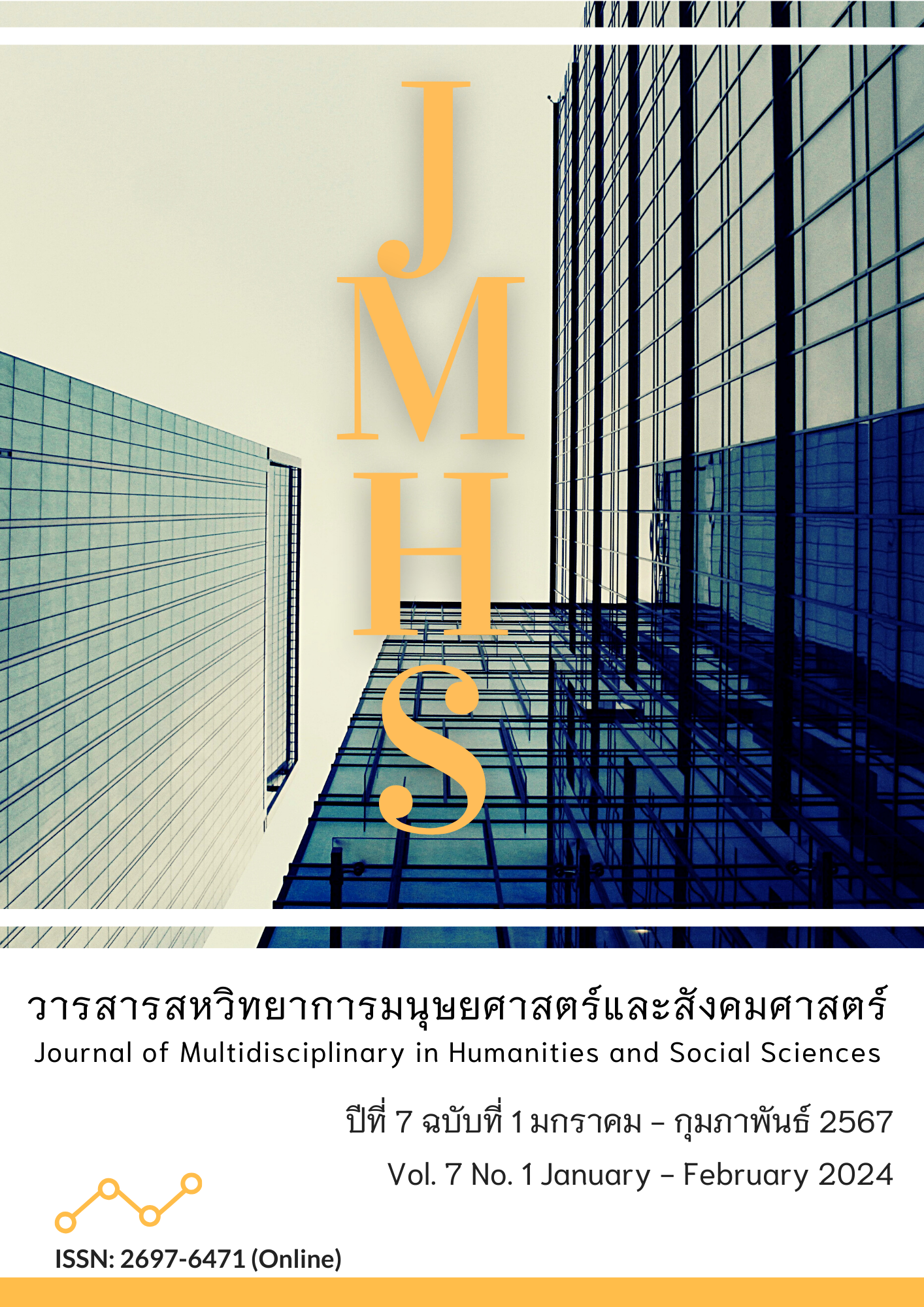Buddhist Art Therapy: Painting Scroll Buddha Images from Vessantara Jataka in Bahn Huai Chomphu, Mae Taeng District, Chiang Mai Province
Main Article Content
Abstract
This article aims to 1) study the knowledge and Buddhist ideology of the Lanna Vessantara Jataka, 2) create religious painting, the scroll Buddha image from Vessantara Jataka, based on contemporary Lanna artists' interpretations, and 3) enhance Buddhist art therapy activities by presenting the scroll Buddha painting and continuing to listen to the Tham Luang tradition. The research technique was a work in progress. The purposive sample group includes 153 persons in total, including abbots, intellectuals, artists, students, government officials, peasants, and local adolescents. The interviews, the Thai's happiness rating, and a set of art learning activity worksheets were among the research instruments.
The study's findings are as follows: 1) The Vessantara Jataka informs about the ideal moral performance of "Giving Perfection." This tale gave rise to the long-held view that listening to sermons is beneficial. The Lanna people refer to this custom as "Tang Tham Luang." It is divided into 13 chapters. 2) The art practice activity entails the creation of 13 scroll Buddha images that are interwoven with art therapy activities. This practice aids in the application of Lanna art pattern knowledge to actual art creation. 3) Those who have continued this tradition and developed works of art from the scroll Buddha painting may investigate and better understand themselves. They are also better able to deal with negative emotions, feelings, and thoughts. In other words, the study found that the Vessantara Jataka story is an important part of the Lanna culture and that it has led to the development of the "Tang Tham Luang" tradition of listening to sermons. The study also found that creating scroll Buddha images can be a powerful form of art therapy.
Buddhist art research may aid in the development of social and communication skills, the understanding of the link between Buddhist art and mental health and well-being, and the development of ways for treating mental health and well-being with Buddhist art.
Article Details

This work is licensed under a Creative Commons Attribution-NonCommercial-NoDerivatives 4.0 International License.
Views and opinions appearing in the Journal it is the responsibility of the author of the article, and does not constitute the view and responsibility of the editorial team.
References
กรมศิลปากร. (2514). มหาเวสสันดรชาดกสำนวนเทศนา 13 กัณฑ์. กรุงเทพฯ: กรมศิลปากร.
กรมศิลปากร. (2527). พระบฏและสมุดภาพไทย. กรุงเทพฯ: อมรินทร์การพิมพ์.
กรมศิลปากร. (2545). พระบฏ. กรุงเทพฯ: กรมศิลปากร.
กรมศิลปากร. (2540). เวสสันตรทีปนี ภาคภาษาบาลี. กรุงเทพฯ: หอสมุดแห่งชาติ.
เกรียงไกร เกิดศิริ. (2550). ปงสนุก : คนตัวเล็กกับการอนุรักษ์. กรุงเทพฯ: อุษาคเนย์.
คงเดช ประพัฒน์ทอง. (2527). พระบฏและสมุดภาพไทย. กรุงเทพฯ: กรมศิลปากร.
ฐานข้อมูลเครื่องมือเครื่องใช้พื้นบ้าน. (2565). พระบฏ. สืบค้นเมื่อ 31 ตุลาคม 2565, จาก
https://www.sac.or.th/databases/traditional-objects/th/equipment-detail.php?ob_id=313
ทวีศักดิ์ สิริรัตน์เรขา และ สมจิตร ไกรศรี. (2553). โปรแกรมศิลปกรรมบำบัด สถาบันราชานุกูล. กรุงเทพฯ: โรงพิมพ์คุรุสภาาดพร้าว.
ทวีศักดิ์ สิริรัตน์เรขา. (2550). ศิลปกรรมบำบัดศาสตร์และศิลป์แห่งการบำบัด. กรุงเทพฯ: โรงพิมพ์คุรุสภาลาดพร้าว.
เธียรชาย อักษรดิษฐ์ และคณะ. (2552). การศึกษาเปรียบเทียบงานศิลปกรรมทางพุทธศาสนาของชุมชนไท เมืองเชียงตุง รัฐฉาน สหภาพพม่า และชุมชนแม่ทะ จังหวัดลำปาง. เชียงใหม่: ศูนย์โบราณคดีภาคเหนือ มหาวิทยาลัยเชียงใหม่.
ปิยะแสง จันทรวงศ์ไพศาล. (2558). ประวัติศาสตร์ทังกา. วารสารวิจิตรศิลป์, 6(2), 74-75. สืบค้นจาก https://so02.tci-thaijo.org/index.php/fineartsJournal/article/view/77246/61997
พงศกร เล็งดี. (2555). การใช้ศิลปะบำบัดกับผู้ป่วยทางจิตเวช. วารสารสถาบันจิตเวชศาสตร์สมเด็จเจ้าพระยา, 6(1), 36-46. สืบค้นจาก https://he01.tci-thaijo.org/index.php/journalsomdetchaopraya/article/view/187575/131759
พระครูสังฆรักษ์ศุภณัฐ ภูริวฑฺฒโน และคณะ. (2561). การตีความภาพพุทธศิลป์ที่ปรากฏในเอกสารโบราณของจังหวัดลำปาง. วารสารวิทยาลัยสงฆ์นครลำปาง, 7(2), 6. สืบค้นจาก https://so04.tci-thaijo.org/index.php/NBJ/article/view/ 252942/171747
พิสิฏฐ์ โคตรสุโพธิ์. (2555). พระมหาเวสสันตรทีปนี : สาระ คุณค่า และนัยสำคัญต่อวิถีสังคมและวัฒนธรรมล้านนา. เชียงใหม่: มหาวิทยาลัยมหาจุฬาลงกรณราชวิทยาลัย วิทยาเขตเชียงใหม่.
ราชบัณฑิตยสถาน. (2556). พจนานุกรมฉบับราชบัณฑิตยสถาน พ.ศ. 2554. กรุงเทพฯ: นานมีบุ๊คส์พับลิเคชั่นส์.
ลิปิกร มาแก้ว. (2562). หลักสูตรลายคำล้านนา (แม่พิมพ์ลายฉลุ). เชียงใหม่: คณะศิลปกรรมและสถาปัตยกรรมศาสตร์ มหาวิทยาลัยเทคโนโลยีราชมงคลล้านนา.
วิทยา พลวิฑูรย์ และ เนติ พิเคราะห์. (2562). งานศิลปกรรมลายคำล้านนา ใน หลักสูตรลายคำล้านนา (แม่พิมพ์ลายฉลุ). ลิปิกร มาแก้ว, วิทยา พลวิฑูรย์ และเนติ พิเคราะห์ผู้เขียน. เชียงใหม่: คณะศิลปกรรมและสถาปัตยกรรมศาสตร์ มหาวิทยาลัยเทคโนโลยีราชมงคลล้านนา.
วิบูลย์ ลี้สุวรรณ. (2526-2527). “พระบฏ: จิตรกรรมไทยที่ถูกลืม. วารสารอักษรศาสตร์มหาวิทยาลัยศิลปากร, 7(1), 137-138. สืบค้นจาก https://so04.tci-thaijo.org/index.php/jasu/article/view 250501/170085
ศิลป์ พีระศรี. (2509). พระบฏในกรุพระเจดีย์วัดดอกเงิน. พระนคร: กรมศิลปากร.
ศิลป พีระศรี. (2515). สมบัติศิลปะจากเขื่อนภูมิพล. กรุงเทพฯ: กรมศิลปากร.
สงวน รอดบุญ. (2545). พุทธศิลปะลาว. (พิมพ์ครั้งที่ 2). กรุงเทพฯ: สายธาร.
สถาบันวิจัยสังคม มหาวิทยาลัยเชียงใหม่. (2552). รายชื่อหนังสือโบราณล้านนา : เอกสารไมโครฟิล์ม (ฉบับปรับปรุง). เชียงใหม่: สถาบันวิจัยสังคม มหาวิทยาลัยเชียงใหม่.
สน สีมาตัง. (2526). โครงสร้างจิตรกรรมฝาผนังล้านนา. กรุงเทพฯ: มหาวิทยาลัยศิลปากร.
สมชาติ มณีโชติ. (2529). จิตรกรรมไทย. กรุงเทพฯ: โอ เอส พรินติ้ง.
สันติ เล็กสุขุม. (2534). ศิลปะเชียงแสน (ศิลปะล้านนา) และศิลปะสุโขทัย. กรุงเทพฯ: มหาวิทยาลัยศิลปากร.
สิงฆะ วรรณสัย. (2523). ปริทัศน์วรรณคดีล้านนาไทย. เชียงใหม่: โครงการตำราคณะมนุษยศาสตร์มหาวิทยาลัยเชียงใหม่.
สุรพล ดำริห์กุล. (2535). ลายคำล้านนา. กรุงเทพฯ: สำนักพิมพ์เมืองโบราณ.
อภิรมย์ สีดาคำ และ เสริมศิลป์ สุภเมธีสกุล. (2552). วรรณกรรมบาลีในประเทศไทย วรรณคดีบาลี. กรุงเทพฯ: มหาวิทยาลัยมหาจุฬาลงกรณราชวิทยาลัย.
อัศนี ชูอรุณ, เลิศศิริร์ บวรกิตติ และ สมชัย บวรกิตติ. (2548). ศัพท์สับสน: ศิลปะบำบัด หรือศิลปกรรมบำบัด. วารสารราชบัณฑิตยสถาน, 30(3), 875. สืบค้นจาก http://legacy.orst.go.th/wp-content/uploads/royin-ebook/257/FileUpload/605_4890.pdf
อาทิตยา สืบมาแต่ปั้น. (2552). เปรียบเทียบพระบฏแสดงภาพพุทธประวัติตอนเสด็จลงจากสวรรค์ชั้นดาวดึงส์ สมัยล้านนาและรัตนโกสินทร์. กรุงเทพฯ: มหาวิทยาลัยศิลปากร.
อุดม รุ่งเรืองศรี. (2546). วรรณกรรมล้านนา. กรุงเทพฯ: สำนักงานกองทุนสนับสนุนการวิจัย.
อู่ทอง ประศาสน์วินิจฉัย. (2548). ท่องทศชาติผ่านจิตรกรรม: เตชสุเนม. กรุงเทพฯ: โรงพิมพ์กรุงเทพ.
เอมอร ชิตตะโสภณ. (2533). ความสัมพันธ์ระหว่างวรรณกรรมล้านนากับวรรณกรรมประจำชาติ. เชียงใหม่: ภาควิชาภาษาไทย คณะมนุษยศาสตร์ มหาวิทยาลัยเชียงใหม่.


